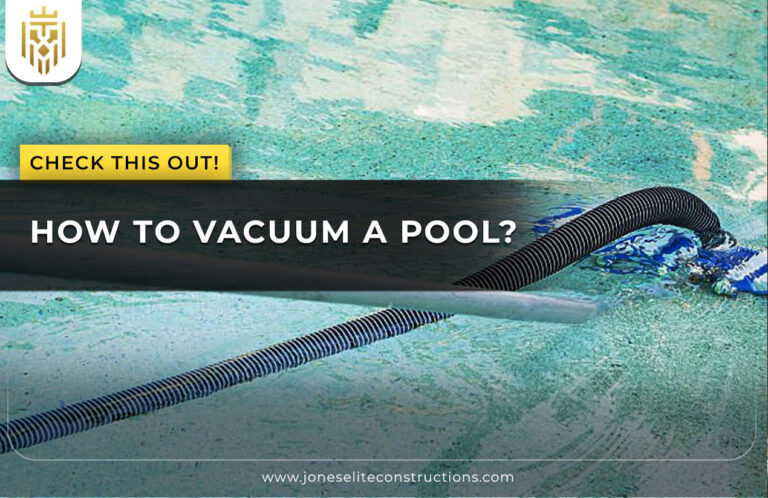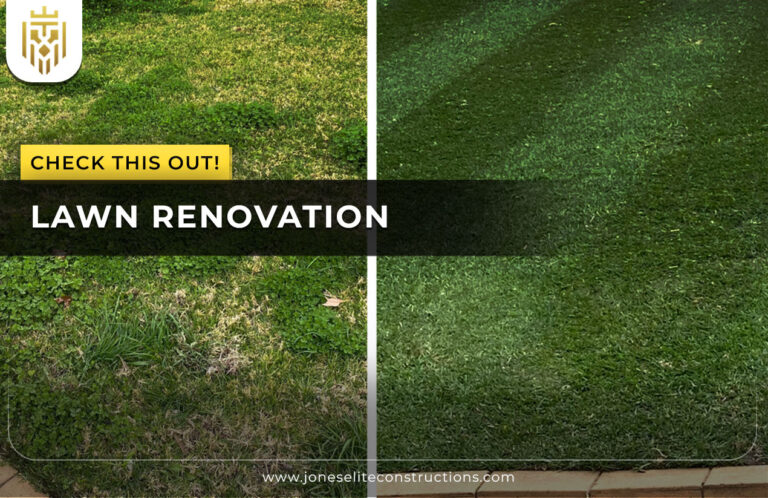What Causes Algae to Grow in Pools?
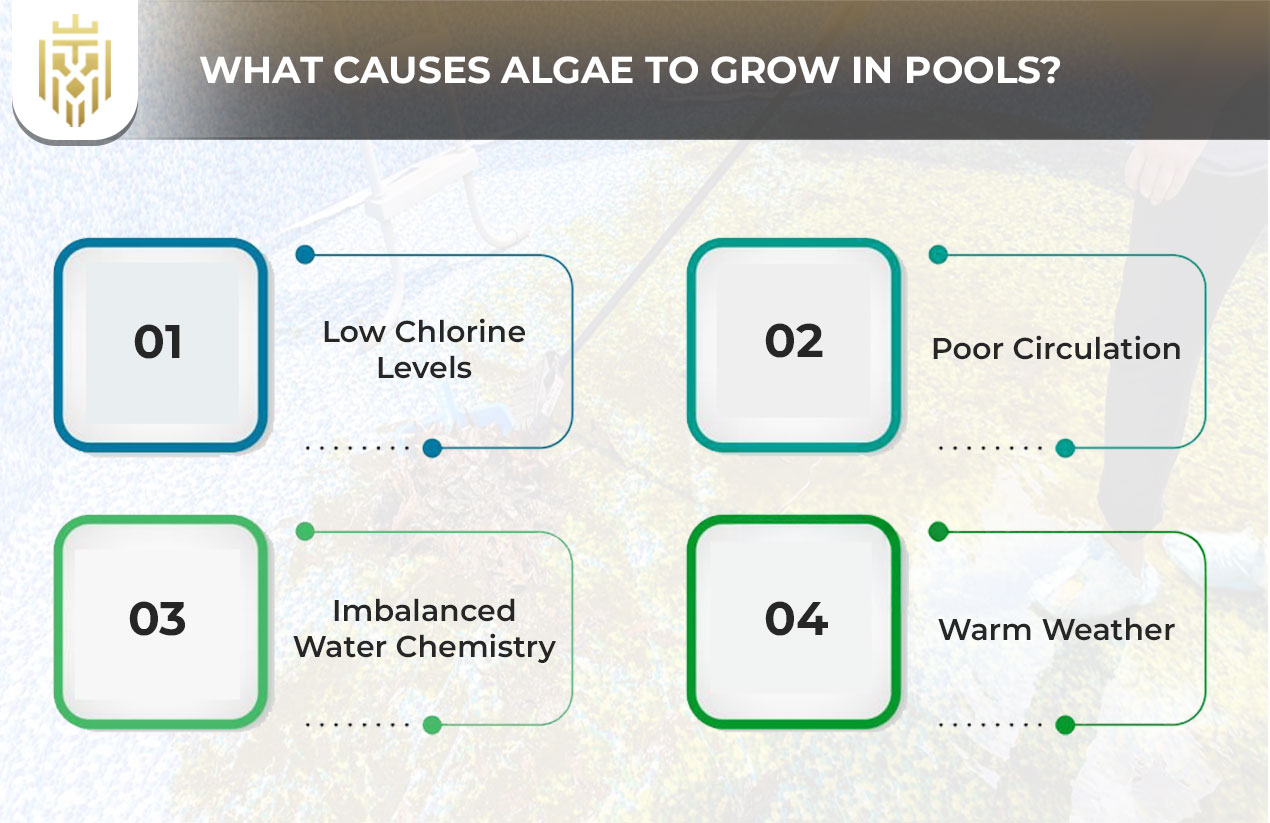
The growth of algae in pools is primarily caused by a combination of poor sanitation, circulation, and environmental factors. Algae grow in slow-moving stagnant water with low chlorine levels, particularly where nutrients such as phosphates are found. The rain also increases their proliferation rates, causing problems such as green algae, black algae, and mustard algae.
Low Chlorine Levels
Chlorine plays a major role in eliminating algae in pools, and when the level is low, it provides an opportune environment to thrive. The lack of sanitizer encourages the rapid growth of microorganisms and creates visible blooms.
Due to excessive use, exposure to the sun, or negligence, low chlorine is likely to occur, exposing the pool to issues such as green algae and murky water.
Poor Circulation
The lack of circulation does not give chlorine and chemicals an equal distribution and leaves patches of space where the algae can proliferate. Ladders, steps, corners, and areas behind them usually form breeding grounds. Even the application of shock treatment of the pool water will not be effective without a powerful movement of water; stagnant water will support growth and allow proliferation of the recalcitrant strains of algae in the pool.
Imbalanced Water Chemistry
Imbalanced pH or alkalinity causes impaired performance of chlorine, and this contributes to the growth of algae spores. As an example, under high pH conditions, sanitizers are rendered ineffective, and thus, outbreaks become more difficult to manage. Unbalanced chemistry normally results in obvious indications of green algae, and constant corrections are needed.
Having the properly tested and maintained balanced water is a guarantee of greater protection against contamination and the general safety of the swimming conditions.
Warm Weather
The sunny weather provides the best condition for quick growth of algae. Heat accelerates chemical decay, which reduces the strength of chlorine, and sunlight increases algae photosynthesis. Even clean pools can easily form mustard algae or green algae blooms (particularly when chlorine levels are not regularly maintained), particularly in high summer. It is important to be taken care of on a regular basis in hot climates.
How to Remove Algae from a Pool?
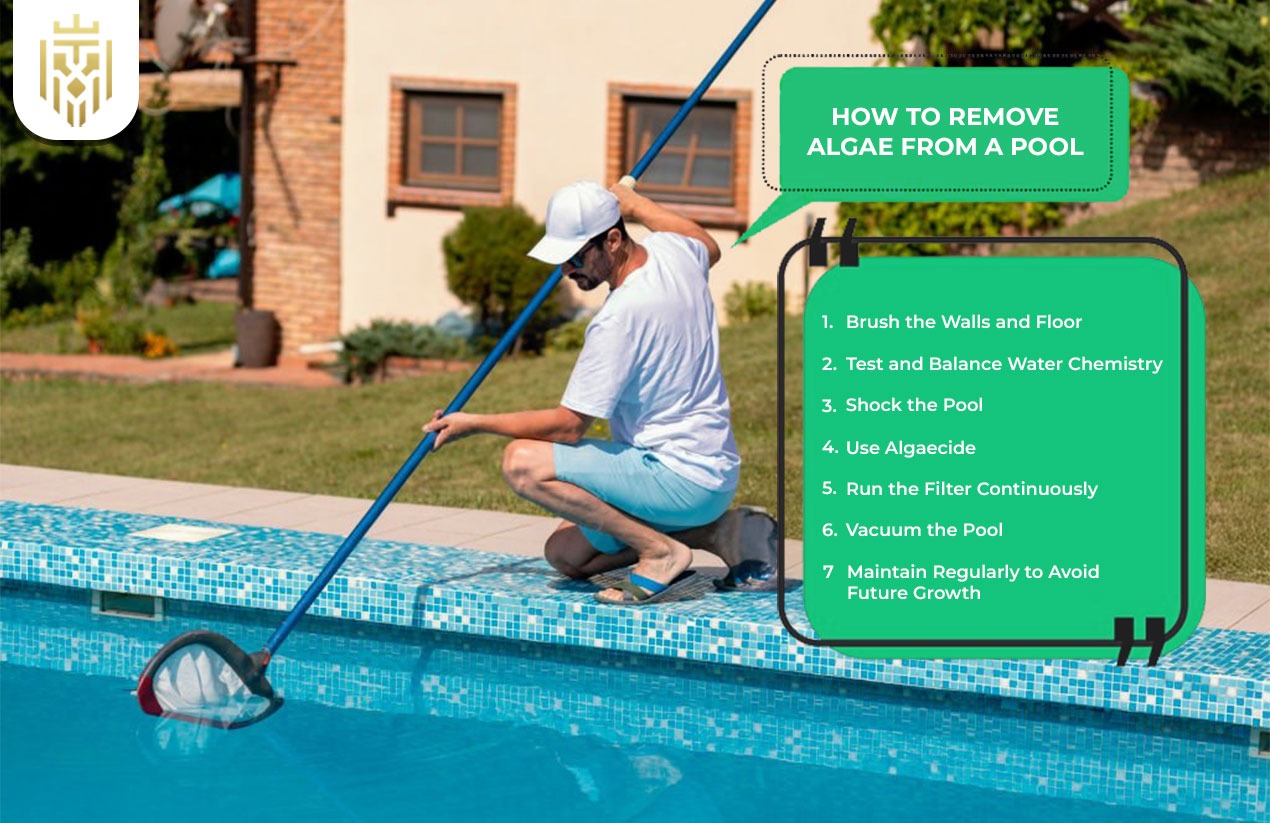
The elimination of algae cannot be done in a haphazard manner. This involves brushing, balancing, shocking, and running the pool filter. The various steps are aimed at eliminating algae at various stages, starting as legacies to the stubborn clumps. Understanding how to remove algae from pool ensures the water remains clear, safe, and inviting for swimmers throughout the season.
Brush the Walls and Floor
Brushing destroys protective layers of algae, leaving them exposed to chlorine and chemicals. This should be done first, prior to the algaecide or shock treatments. Constant scrubbing will help avoid accumulation of dirt on walls, floors, and steps where such stubborn varieties as black algae will take root. Brushing properly will help loosen the growth, leaving the blooms exposed to the efficiency of sanitizers.
Test and Balance Water Chemistry
Test pH, alkalinity, and chlorine as a pre-treatment of algae. Water balance guarantees the effective functioning of sanitizers, enabling the minimization of lost labor. An example is acidic or alkaline imbalances, which permit the growth of algae even with the application of chemicals. Equilibrium recovery also assists in the preparation of pool shock, and further clean-up attempts will become much more effective in the destruction of spores and the maintenance of a sanitized pool.
Shock the Pool
A high dose of chlorine applied as a shock will kill off the algae in a relatively short period and restore suitable conditions to the water in time to allow swimming. Organic contaminants are oxidized in a cost-effective way by pool shock treatments, which eliminate spores that cannot be seen by the eye. In case of severe cases, several shocks can be required. This is among the surest measures in addressing algae issues, particularly in warm months and months when it is used a lot.
Use Algaecide
Algaecide supplement is an addition of chlorine, which is directly applied to the resistant strains. It is used when brushing and shocking to stop the growth of spores. Some recipes are specific to mustard algae or green algae so that they are treated uniquely. Algaecide is not a replacement for chlorine but rather an addition to improve efficacy. That is why the use of algaecide is an essential measure in long-term algae management and prophylaxis.
Run the Filter Continuously
After shocking or algaecide treatment, it is necessary to install a clean and efficient pool filter. Continuous filtration removes the particles of dead algae, making the water clearer and minimizing recontamination. Due to the dirty filters, the spores can be reintroduced into the circulation at the expense of cleaning. Operating the system for at least 24-48 hours will guarantee the removal of debris that is trapped in the system, restoring the health and balance of the pool.
Vacuum the Pool
Vacuuming eliminates algae residue, soil, and biological debris that nourish new growth. Vacuuming can be done manually or automatically, whereby even concealed areas have been swept. This action is the complement of brushing and filtering, and the pool is left clean. Lacking vacuuming, dead algae will settle in the suspension, which is the cause of clogging filters in the pool and stimulating the reoccurrence of contamination even with using the chemicals and making the pool clean after each use.
Maintain Regularly to Avoid Future Growth
It is simpler to avert algae rather than eliminate it. Regular maintenance, such as brushing, balancing chemistry, and running the circulation system, helps avoid risks. Knowing how to remove algae from pool is useful, but prevention saves time and effort. Constantly maintaining the pools prevents the spores of algae from having more chances to multiply, thus keeping pool water always clean and safe.
How to Remove Green Algae from a Pool?
To understand how to remove green algae from a pool, start by shocking the water, brushing the walls, and ensuring circulation. This type propagates rapidly, causing water to become opaque or oily. It is effectively cleared using chlorine-based shock and filtration.
This form of algae is common in pools and is controlled by preventive measures such as maintaining chlorine balance, which contain recurrent outbreaks of the same.
How to Remove Black Algae from a Pool?
When dealing with how to remove black algae from pool, extra effort is needed since this strain roots deep into surfaces. Vigorous scrubbing, intense pool shock, and special algaecides are necessary. The chlorine resistance characteristics of black algae make it difficult to treat, and one should remain persistent.
Regular scrubbing and chemical reinforcement will be done to ensure that all have been completely removed and no stubborn blooms come back.
How to Remove Mustard Algae from a Pool?
Learning how to remove mustard algae from pool involves extra care since it clings to shady areas and resists chlorine. Shocking followed by the application of special algaecides is useful in eradicating it. Underlying areas are essential in terms of scrubbing.
Swimsuits or equipment are the normal source of mustard algae, and disinfecting the accessories will guarantee long-term achievements and minimize the chances of reoccurrence.
Tips to Prevent Algae Growth in Your Pool
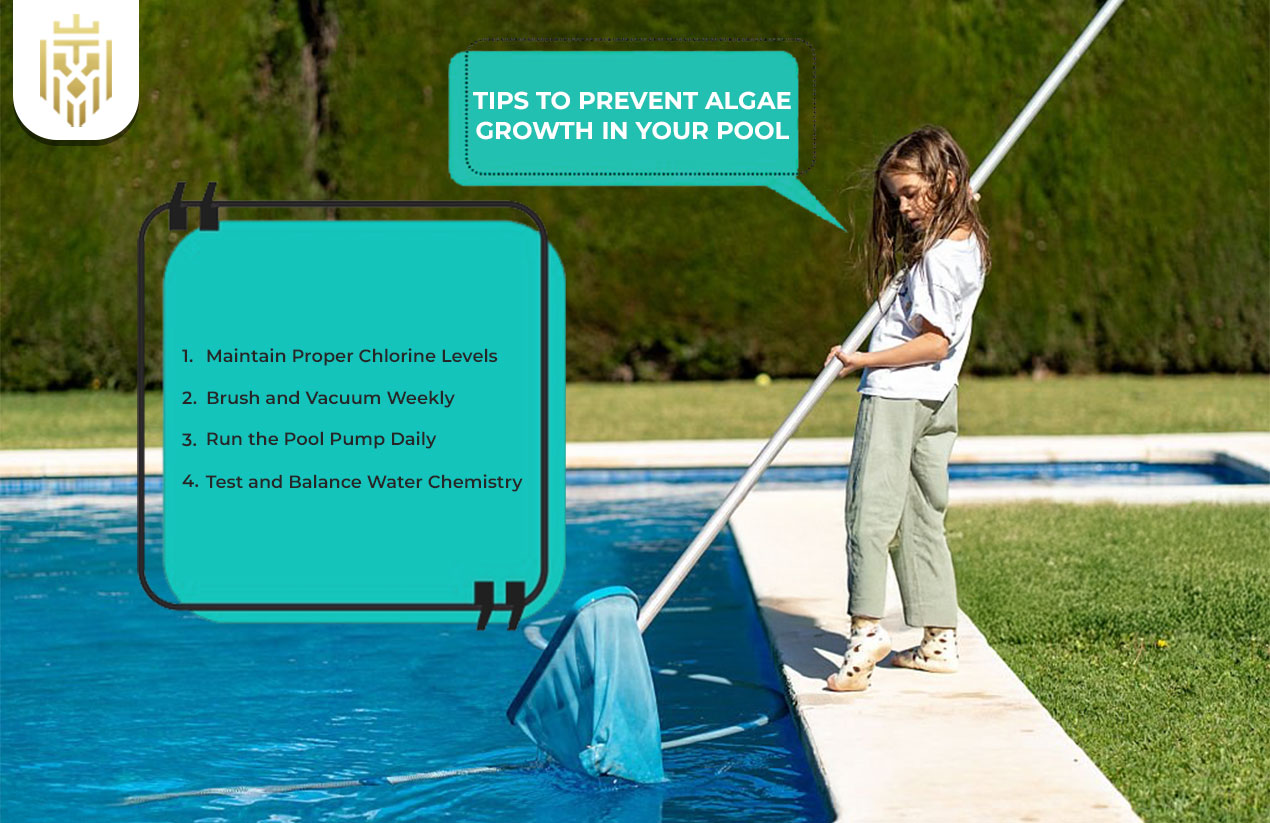
The process of prevention is a combination of regular cleaning, appropriate circulation and chemical treatment. Prevention of green algae, mustard algae or black algae: it is safe as long as one tries to do it on a regular basis. There is a schedule of brushing, vacuuming, checking and maintaining chlorine, which ensures the water is clear. Prevention helps in saving time as opposed to addressing challenging outbreaks in the future.
Maintain Proper Chlorine Levels
By keeping chlorine at desired levels, algae spores can be prevented from multiplying. Balance should regularly be checked, and this is done particularly in the case of heavy pool usage or hot weather. This is the most appropriate measure in preventing repeat infestations. The strength of chlorine prevents the water from becoming a breeding ground by which the algae of the pools can grow, and thus swimming is considered safe and clear and hygienic throughout the season.
Brush and Vacuum Weekly
Brushing and vacuum cleaning every week helps in preventing the growth of stubborn ones, particularly in shaded parts. These measures literally destroy spores before they propagate. Algae will tend to grow in hidden places; hence, frequent cleaning is essential. Combined with an effective pool filter, weekly maintenance prevents sparkling water and prevents outbreaks from further developing into large and difficult-to-eliminate ones.
Run the Pool Pump Daily
Operating the pump on a daily basis maintains circulation, eliminating non-circulatory areas where the algae prosper. The flow of water enables an equal distribution of chlorine and chemicals to ensure that treatments are more effective. Even pool shock does not stand even without circulation. With regular working of the pump, the water is kept clean, and the danger of algae accumulation will be minimized, and the pool will be clean and inviting to swimmers.
Test and Balance Water Chemistry
Regular tests inhibit chemical imbalances which undermine the efficacy of chlorine. Monitoring of pH, alkalinity, and chlorine helps pool owners to maintain high levels of algae resistance. Equal-footing chemistry mitigates outbreaks and promotes preventive treatments. Along with brushing, circulation, and regular cleaning, balanced water is the basis of long-term prevention of algae issues in the pools on a regular basis, even in the seasons of active swimming.
FAQs
1) What Causes Algae to Grow in Pools?
Low chlorine, poor circulation, unbalanced water chemistry and warm temperatures all encourage the growth of the algae in pools. Spores do well under these conditions, resulting in green algae, black algae or mustard algae outbreaks.
2) How to Remove Algae from a Pool?
The instructions on how to remove algae in the pool, brush the pool walls, balance the water chemistry, use pool shock, add algaecide, run the pool filter, and vacuum properly to guarantee that there are no algae spores and the water is clean.
3) How to Remove Green Algae from a Pool?
Knowing how to remove green algae from a pool involves shocking with chlorine, brushing surfaces, and running the filter continuously. Maintaining water chemistry also prevents the recurrence of blooms in the pool by maintaining clarity and ensuring the safety of the water.
4) How to Black Algae from a Pool?
When learning how to remove black algae from pool, persistent brushing, multiple pool shock treatments, and specialised algaecides are essential. Regular washing removes the growth that enhances its deep roots, hence avoiding the re-emergence of resistant algae.






